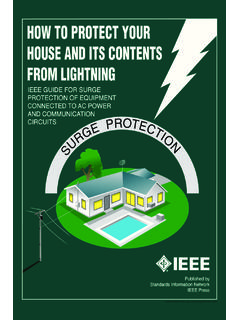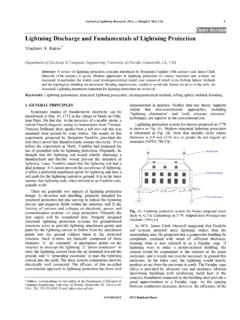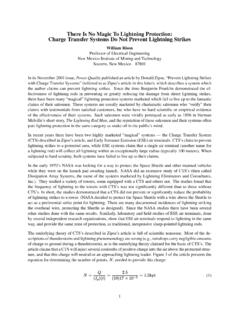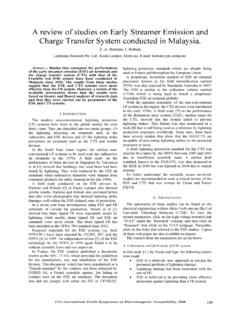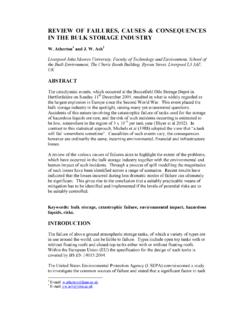Transcription of TRADOC Guide Lightning Protective Measures for …
1 Army Training and Doctrine Command Guide for Lightning Protective Measures for Personnel January 2002 Table of Contents Section Page Introduction 1 The Typical Lightning Accident 1 Lesson Learned 1 Discussion of Lightning Phenomena and Hazards 2 Introduction to Lightning Hazards 2 Assessment of Lightning Risk 4 Personnel Hazards 6 Lightning Detection, Warning and Safety Procedures 8 Lightning Detection 8 Warning Procedures 9 Safety Criteria and Procedures 9 Shelter Specifications 12 Shelter Introduction 12 Strike Terminations 13 Downconductors 15 Grounding System 16 Site Considerations 18 References 19 Introduction This document is intended to provide information to installations for the development of defenses against Lightning for the protection of personnel.
2 It provides a concise discussion of Lightning phenomena, hazards, personal defenses and engineering defenses. In Army operations, lives are lost and many injuries are incurred each year by Lightning . Analysis of these mishaps indicate that some simple steps, based on knowledge of Lightning and the associated hazards, may have prevented some of these accidents. The Typical Lightning Accident Although there is probably no such thing as a typical accident, most Army Lightning mishaps have several things in common. These are: -Troops are in unimproved shelters, usually in tentage, or in the open. -Troops are working with antenna/mast equipment. -Troops are using field phones. -Troops are not informed about Lightning hazards and consequently took no action. -Troops had no prior warning of approaching Lightning other than audible and visual warnings.
3 -Troops are most often affected by indirect Lightning current, rather than being directly struck by Lightning . The most severe mishaps occur while troops were in the field, sleeping in tents. Lightning then strikes nearby, to a tree or even to the tent pole and the resulting current from the strike affects soldiers nearby. Fatalities from indirect Lightning events have occurred at ranges of 40 to 60 feet from the point of the Lightning strike. Lessons Learned From the review of the accidents, we have learned that there are three essential elements of personnel protection from Lightning . 1 Knowledge; What to do if Lightning threatens, development of a plan to protect troops. Knowledge of first aid procedures for electrical shock is also important. 2 Warning; Advance warning of approaching Lightning . 3 Shelter; Where to take shelter from Lightning .
4 Consider that many structures that provide shelter from the elements will not protect from Lightning effects and actually increase risk. In this Guide , we address all three of these elements and provide guidance for implementation. 2 CURRENT, AMPERES X 1032000 TIME, SECONDS X 10-6 ABC400 X 106dI/dt = 3 X 1010 A/sFigure 1 Representative Lightning event. Discussion of Lightning Phenomena and Hazards Introduction to Lightning Hazards To better understand how to protect personnel and facilities from Lightning we will briefly discuss Lightning characteristics, the Lightning attachment process and Lightning hazards. Lightning Parameters A Lightning strike is essentially a high amplitude direct-current pulse with a well-defined waveform. While there are several types of Lightning , the type that concerns us is cloud to ground Lightning .
5 Understanding of the waveform of cloud to ground Lightning is useful to the designer in formulating a protection system. Precisely how Lightning is generated and how it is propagated to earth does not impact design greatly, therefore it is not within the scope of this report. The Lightning pulse is divided into four parts, components A to D. Figure 1 illustrates a Lightning waveform. Component A is the high-current pulse. It is a direct current transient that has been recorded to reach up to 260,000 amperes and last for a duration of up to 200 microseconds. Typical rate of current rise with respect to time is 3 X 1010 A/s, but could reach 2 X 10 11 A/s. On the average, it will reach 20,000 amperes for a 50 microsecond duration. Strikes above 200,000 amperes are considered rare. Component B is a transition phase on the order of several thousand amperes.
6 Component C is a continuing current of approximately 300-500 amperes that lasts up to .75 second. The last component, D, not shown, is a restrike surge that is typically half that of component A in a given strike. It has generally the same duration as component A. Typically 3 or 4 restrikes will occur in one Lightning event but the maximum observed is 26 restrikes in one Lightning event. Sources differ on the magnitude of 'D'; some state all restrikes are one-half the magnitude of the A component and some sources imply that the D component continually decreases by one-half ( , 1/2A, 1/4A, 1/8A, etc.). Lightning Attachment Process Let us examine how Lightning interacts with the ground and how it attaches to objects on the ground. Most Lightning that reaches the ground (over 90%) is negatively charged. It begins to intercept the ground by lowering a stepped leader - a precursor to the actual Lightning discharge.
7 This leader progresses in steps toward the ground and is comprised of electric charge. It 3completes this process in a length of time measured in tens of milliseconds. Below the leader is a region of very high electric field. As the leader approaches the earth, the high electric field induces objects on the ground to emit leaders of opposite polarity charge. Since opposite charges attract, the path of the downward leader is influenced by an upward leader of opposite polarity. Upon connection, the actual current discharge associated with Lightning begins as shown in figure 2. Rolling Sphere Model of Lightning The final step in the Lightning attachment process occurs at a point during the downward leader progression, when the leader decides toward which upward leader it will travel. As the downward leader approaches the objects on the ground, it is attracted to upward emitted leaders.
8 A model of Lightning propagation used today to represent this final step is the rolling sphere model as illustrated in figure 3. It s important to point out that this is largely an empirical model that models the observed behavior of Lightning . Once the downward leader is within a certain radius, known as the striking distance, the upward and downward leader attract and connect. The striking distance is defined in the NFPA 780 as the distance over which the final breakdown of the initial Lightning stroke occurs. The sphere used in the model eventually intersects an object on the earth s surface. This object can be a tree, structure or person. At that time, we expect that the tip of the leader located at the center progresses rapidly toward the object intersecting the sphere. Taller objects generally have an advantage since they are closer to the stepped leader and begin to emit their own leader sooner.
9 From this type of model, we derive the concept of attractive area, which is explained in the next section. STEPPEDLEADERSINDUCED LEADERSLIGHTNINGSTROKE Figure 2 - Illustration of Lightning Attachment. PATH OFDOWNWARDLEADERSTRIKINGDISTANCEROLLING BALL Figure 3 - Rolling Sphere Model of Final Lightning Attachment Step. 4 Assessment of Lightning Risk To determine the probability of strike several variables are considered such as geographical location, time of year and structural configuration. Probability of Strike The first aspect of Lightning risk is the probability of strike. The procedure used to assess a probability of strike is to calculate an attractive area for the object in question. The term attractive area is the common phrase used but is really not the best choice of words since Lightning events initiate without influence from features close to the ground.
10 The attractive area really represents a zone where there is a high probability of Lightning striking the object in question in the event that Lightning initiates overhead within that zone. Once the attractive area is known, it is compared with the flash density to find the expected number of Lightning attachments to the object within a period of time. A coefficient is also sometimes used to account for other objects/structures nearby. Determination of Lightning Attractive Area A key variable in the assessment of Lightning probability is the Lightning attractive area, Ae. Strike frequency is proportional to the attractive area. The attractive area is determined by finding the area of the structure and adding a region equal to three times the structure height. Expressing this mathematically, we find the attractive area: Where: L= length [km], W= width [km], H= height [km] In cases of a prominent singular structure or prominent part of the structure, then the attractive area reduces to: Geographical Factors The next step in the probability determination is to find the product of the attractive area and the Lightning flash density of a given particular geographical area and account for the local environment of the structure.
